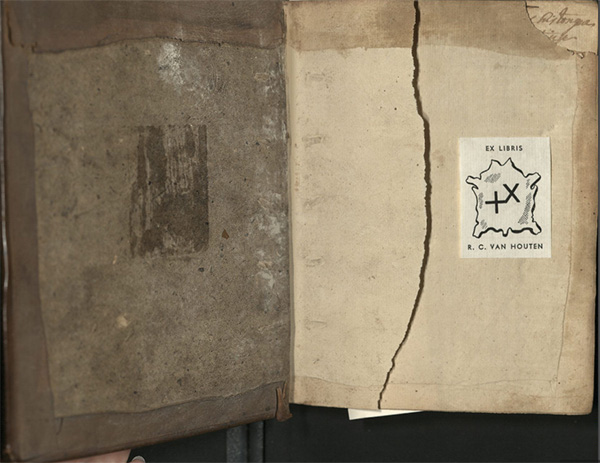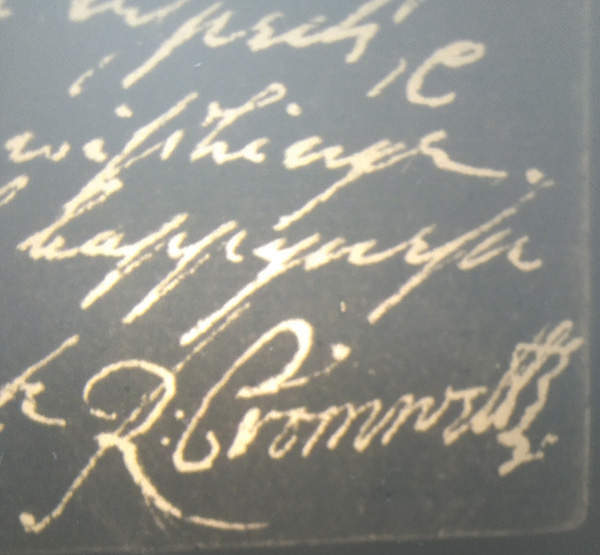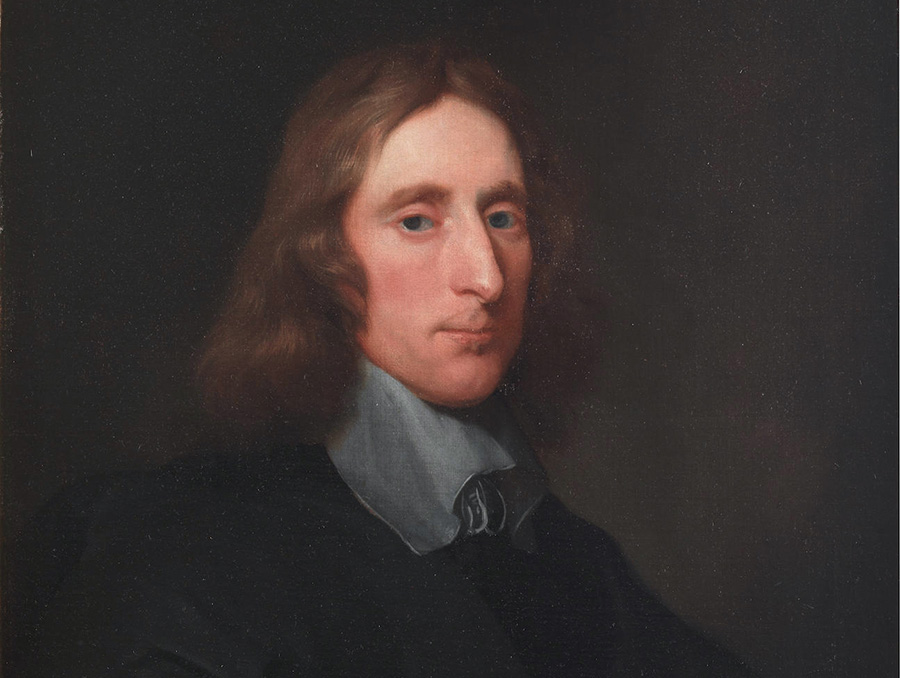In the course of conducting a condition assessment survey of pre-1800 bound materials, Special Collections and University Archives has identified a volume bearing an owner’s signature of possible significance.
The volume in question, a 1634 edition of Richard Verstegan’s “A Restitution of Decayed Intelligence in Antiquities: Concerning the most noble, and renowned English Nation,” has a number of unsigned 18th- or early 19th-century handwritten notes and inscriptions on the blank leaves before the title page. On the title page itself, an earlier hand has written the name “Ric. Cromwell.” Consultations with experts in 17th century English history and handwriting have led to the conclusion that this is probably the signature of Richard Cromwell, third son of Oliver Cromwell, and second and final Lord Protector of the Commonwealth of England, Scotland, and Ireland in 1658-9.
Who was Richard Cromwell?
Richard Cromwell was born in October 1627, in Huntingdon, England. Not much is known of his childhood and education beyond enrollment at Felsted School in Essex. He truly enters the historical record in 1647 with membership in Lincoln’s Inn and the New Model Army. This is the army that eventually came under the leadership of Oliver Cromwell and defeated the Royalist forces during the English Civil War. Oliver Cromwell took power in 1653 and ruled as king in all but name under the title Lord Protector until his death in 1658.

The details of the English Civil War and Oliver Cromwell’s rise to power have been well-documented and extensively studied, but Richard remains a somewhat elusive historical figure, a brief blip between his forceful father and the restoration of the Stuart monarchy under Charles II in 1660. During his father’s five years as Lord Protector, Richard spent time with his wife and children in Hampshire, served as a county Justice of the Peace, and eventually joined the Protectorate parliaments, first as a member for Huntingdon and later for Cambridge University.
Many sources comment upon Richard as a source of concern for Oliver, who seemingly thought his son insufficiently serious for the needs of the time. There is documentary evidence suggesting Richard Cromwell had trouble managing his property and funds, and preferred hunting as a daily activity. It is certainly notable that it took two years into the Protectorate for Richard to gain any public appointment from the government, and that Oliver Cromwell is noted as saying that if Parliament wished to make the Protector’s role hereditary he would have rejected it. Though Richard did gain more prominent roles over the next few years, it is clear he did not have the respect his father inspired in others, nor the base of support that would come with respect.
Upon Oliver Cromwell’s death in late 1658, Richard was proclaimed Lord Protector. Initial signs of peaceful transition were rapidly replaced by rumors of conspiracy and general lack of trust in his leadership. Under pressure from the army and Parliament, after about nine months of serving as Lord Protector, Richard Cromwell resigned in May 1659. In 1660, Richard Cromwell departed England for exile in Europe, sometimes living under pseudonyms, and never saw his wife again. He finally returned to England around 1680 and lived quietly until his death in 1712, nearly outliving the Stuart dynasty itself.
At 85 years, he is the second longest-lived British head of state, surpassed only by the late Queen Elizabeth II. At nine months, he is one of the shortest-ruling British heads of state, often referred to by the scornful nickname “Tumbledown Dick.”
Richard Verstegan’s 1634 edition of “A Restitution of Decayed Intelligence in Antiquities: Concerning the most noble, and renowned English Nation”

How this 1634 edition of Richard Verstegan’s work of English history came into the Libraries’ hands is unclear at this point, provenance information for books often being difficult to trace over centuries. There is a modern bookplate tucked inside the front cover with the name “R.C. Van Houten,” but so far that clue has borne no fruit. While it is possible that the binding is contemporary with the edition, there are some reasons to suspect it has been rebound. The top margin is trimmed very close to the text, actually slightly cutting into some page headings, and the front cover does not close fully without external pressure. Then again, at nearly four hundred years old, perhaps these are just signs of something that was rather cheaply bound to begin with, an inexpensive edition for a student.
Consulting with scholars and experts
When the Cromwell signature was first noted in January of this year, the Libraries reached out to 17th century scholars Dr. David Como at Stanford University and Dr. Peter Gaunt at the University of Chester for assistance, both of whom provided the Libraries with digital images of verified Richard Cromwell signatures.


The Libraries also received advice from Dr. Heather Wolfe, a paleography expert at the Folger Shakespeare Library in Washington, D.C., and had significant correspondence and aid from Stuart Orme, curator of the Cromwell Museum in Huntingdon, UK, and the team of experts in his local network.
The Libraries can say with confidence that the signature is likely contemporary to the book, and that there is a strong resemblance to confirmed signatures of Richard Cromwell, second Lord Protector. The downstroke of the capital R, with the hook element at the top, and several characteristics of the double “l” at the end of the surname, are extremely similar. The double “l” has a cross mark across it, and a squiggled line at the end, almost making it look like a possessive “s.” That said, there are certainly possibilities that it is not him: he was not the only Richard Cromwell alive at the time, and this volume was published when he was a child under ten years of age. Without in-person examination by specialists and a supporting line of provenance for the book’s history, however, it is impossible to be entirely certain. The experts consulted agreed with the assessment that there is a striking resemblance to confirmed signatures, but were not able to examine more than digital images. Therefore, we are describing it as a possible or probable signature, and hope that scholarship will one day determine whether or not it is indeed the handwriting of the elusive Richard Cromwell.
About Special Collections and University Archives
To learn more about this discovery contact Elspeth Olson, Outreach and Public Services Archivist, University Libraries, Special Collections and University Archives.
Special Collections and University Archives contains the University Libraries' rare books, book arts collection, manuscript collections, and university archives. The materials in Special Collections are available to all individuals for research and scholarship. To learn how to partner with the Libraries please visit the helpful webpage with information on printing, resources available, event support and how to locate materials.
















